
Students use knowledge of place value to explain how to make the number with the least value.
- Subject:
- Education
- Material Type:
- Activity/Lab
- Assessment
- Homework/Assignment
- Date Added:
- 08/10/2018

Students use knowledge of place value to explain how to make the number with the least value.

This is a task from the Illustrative Mathematics website that is one part of a complete illustration of the standard to which it is aligned. Each task has at least one solution and some commentary that addresses important asects of the task and its potential use. Here are the first few lines of the commentary for this task: 127 is a number. Write it as a sum of 100's, 10's, and 1's. Write its name in words. Draw a picture to represent the number. Locate it on the number li...
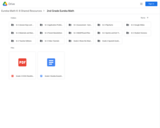
2nd Grade Eureka Math
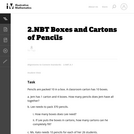
This instructional task requires students to figure out word problems that require thinking in base 10.
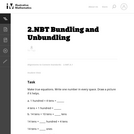
In this task students determine the number of hundreds, tens and ones that are necessary to write equations when some digits are provided. Students must, in some cases, decompose hundreds to tens and tens to ones.
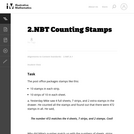
This is an instructional task related to deepening place-value concepts. The important piece of knowledge upon which students need to draw is that 10 tens is 1 hundred.
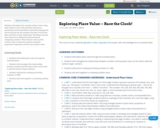
Students will explore the concepts of place value using their bodies as tools. They will time themselves performing various kinesthetic tasks like jumping jacks and sit ups and use the numbers that they record from these activities in their exploration. Working in groups, they will practice adding and subtracting and comparing numbers. They will also come up with creative ways to represent numbers using the properties of operation and the rules of place value.
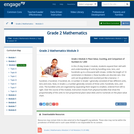
In this 25-day Grade 2 module, students expand their skill with and understanding of units by bundling ones, tens, and hundreds up to a thousand with straws. Unlike the length of 10 centimeters in Module 2, these bundles are discrete sets. One unit can be grabbed and counted just like a banana?1 hundred, 2 hundred, 3 hundred, etc. A number in Grade 1 generally consisted of two different units, tens and ones. Now, in Grade 2, a number generally consists of three units: hundreds, tens, and ones. The bundled units are organized by separating them largest to smallest, ordered from left to right. Over the course of the module, instruction moves from physical bundles that show the proportionality of the units to non-proportional place value disks and to numerals on the place value chart.
Find the rest of the EngageNY Mathematics resources at https://archive.org/details/engageny-mathematics.
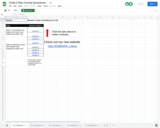
Eureka Math videos- sums and differences to 20.
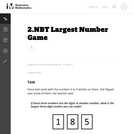
This word problems helps students learn to build the biggest three-digit number given any three numbers between 0 and 9 to use as digits.
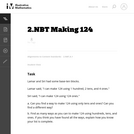
This task is for students who know how to use base 10 blocks.

(Nota: Esta es una traducción de un recurso educativo abierto creado por el Departamento de Educación del Estado de Nueva York (NYSED) como parte del proyecto "EngageNY" en 2013. Aunque el recurso real fue traducido por personas, la siguiente descripción se tradujo del inglés original usando Google Translate para ayudar a los usuarios potenciales a decidir si se adapta a sus necesidades y puede contener errores gramaticales o lingüísticos. La descripción original en inglés también se proporciona a continuación.)
En este módulo de 25 días de grado 2, los estudiantes amplían su habilidad y comprensión de las unidades agrupando, decenas y cientos de hasta mil con pajitas. A diferencia de la longitud de 10 centímetros en el módulo 2, estos paquetes son conjuntos discretos. Una unidad puede ser agarrada y contada como un plátano? 1cientos, cientos, 3cientos, etc. Un número en el Grado 1 generalmente consistía en dos unidades, decenas y otras diferentes. Ahora, en el grado 2, un número generalmente consta de tres unidades: cientos, decenas y otras. Las unidades agrupadas se organizan separándolas más grandes a más pequeñas, ordenadas de izquierda a derecha. En el transcurso del módulo, la instrucción se mueve de los paquetes físicos que muestran la proporcionalidad de las unidades a discos de valor del lugar no proporción y a los números en la tabla de valor del lugar.
Encuentre el resto de los recursos matemáticos de Engageny en https://archive.org/details/engageny-mathematics.
English Description:
In this 25-day Grade 2 module, students expand their skill with and understanding of units by bundling ones, tens, and hundreds up to a thousand with straws. Unlike the length of 10 centimeters in Module 2, these bundles are discrete sets. One unit can be grabbed and counted just like a banana?1 hundred, 2 hundred, 3 hundred, etc. A number in Grade 1 generally consisted of two different units, tens and ones. Now, in Grade 2, a number generally consists of three units: hundreds, tens, and ones. The bundled units are organized by separating them largest to smallest, ordered from left to right. Over the course of the module, instruction moves from physical bundles that show the proportionality of the units to non-proportional place value disks and to numerals on the place value chart.
Find the rest of the EngageNY Mathematics resources at https://archive.org/details/engageny-mathematics.
![OREGON MATH STANDARDS (2021): [2.NBT]](https://img.oercommons.org/160x134/oercommons/media/courseware/lesson/image/13138_ODE_Math_Logo_2018-H_color_BvjqVNy.png)
The intent of clarifying statements is to provide additional guidance for educators to communicate the intent of the standard to support the future development of curricular resources and assessments aligned to the 2021 math standards. Clarifying statements can be in the form of succinct sentences or paragraphs that attend to one of four types of clarifications: (1) Student Experiences; (2) Examples; (3) Boundaries; and (4) Connection to Math Practices.
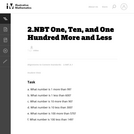
This task acts as a bridge between understanding place value and using strategies based on place value for addition and subtraction.

The point of this task is to emphasize the grouping structure of the base-ten number system, and in particular the crucial fact that 10 tens make 1 hundred.
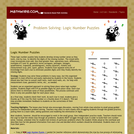
These logic number puzzles help students develop strong number sense as they work, clue by clue, to identify the digits of the missing number. The mixed-skills clues incorporate even-odd, less than-greater than, operations (sum, difference), multiples of 5 and 10, geometric terms (octagaon, pentagon, hexagon, quadrilateral, trapezoid, parallelogram), money (quarters, nickels) and measurement (cup, pint, quart, gallon). Students must squeeze every bit of knowledge from each clue to eliminate possible digits until they finally identify the missing digits.
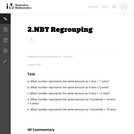
This task serves as a bridge between understanding place-value and using strategies based on place-value structure for addition.

These word problems about money require students to think in base 10.
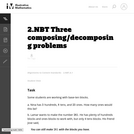
The purpose of this task is to help students understand composing and decomposing ones, tens, and hundreds. This task is meant to be used in an instructional setting and would only be appropriate to use if students actually have base-ten blocks on hand.
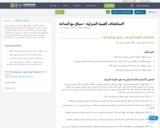
سيستكشف الطلاب مفاهيم القيمة المنزلية باستخدام أجسامهم كأدوات. سيقومون ببعض المهمات الحركية الموقوتة كالقفز وضغط البطن وسيستخدمون الأعداد التي سجلوها من تلك النشاطات في استكشافهم. وأثناء عملهم في مجموعات سيتمرنون على جمع الأعداد وطرحها ومقارنتها. كذلك سيبتكرون طرقًا خلاقة لتمثيل الأعداد مستخدمين خصائص العمليات الحسابية وقواعد القيمة المنزلية.